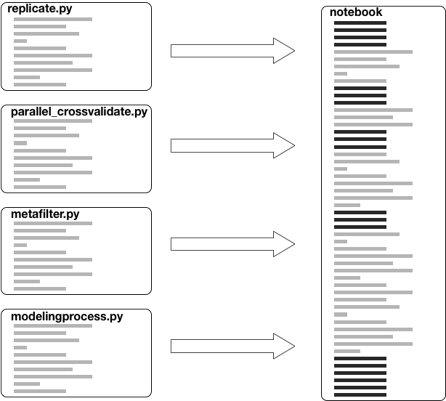Defactoring in Practice
At a practical level, we have copied the code from Underwood and Sellers’ Pace of Change git repository and restructured their code into a Jupyter Notebook. Transforming Underwood and Seller’s code from a set of Python scripts into the notebook involved a series of transformations to their code. The provenance of this effort has been preserved because we did all of our work in a fork of their version repository, visible via the git history command.
Underwood and Sellers’s wrote their code to make it easy to replicate their results by running a single command. One of our first tasks was to trace their code following the path of execution from the initial command to the output data files. By reading the code that spanned multiple python scripts, we could obtain a rough idea of how Underwood and Sellers’s analysis of poetry volumes was performed in practice. The first step of reading their code involved translating their python scripts into a Jupyter Notebook. Plain text files leave much to be desired with trying to critically interrogate code, the Jupyter Notebook format and platform enables a much richer reading experience. Translating Underwood and Sellers’s scripts involved copying snippets of code from multiple Python (.py) files into a single executable notebook. For code that was not already authored in a notebook, this requires significant effort curating and restructuring the code to fit the linear structure of the notebook while preserving the functionality of Underwood and Sellers’s scripts.
Not all of the code in the git repository was copied into the notebook for two main reasons. First, not all of the code included in the files was actually needed to replicate the analysis. The repository includes additional code, one could call it “cruft”, from Underwood and Seller’s exploratory analysis or earlier iterations of their analytical process. For example, the file SonicScrewdiver.py is never called upon although, based upon the name, we might hypothesize it is an important catch-all module for a variety of different functions. Other sections of the code are commented out and thus never executed (such as binormal_select discussed below). As part of the defactoring process, we opted to not include unused functions or code blocks. Another reason that the code of Sellers and Underwood was not copied verbatim is because we do not represent all possible executions paths of the code. Their code included execution paths that trained multiple models of the data broken into twenty-year periods, but their final analysis trained a model on the entire dataset. In this notebook we follow the default option, “full”, which models the entire dataset.
Underwood and Seller’s code is stored within four Python files, replicate.py, parallel_crossvalidate.py, metafilter.py, and modelingprocess.py. Through the process of defactoring we have copied some, but not all, code from the Python text files to a Jupyter Notebook. This process has transformed the structure and flow of the code, but not the functionality. Like refactoring, the inputs and outputs and overall functionality remain the same, but our process has restructured the code to be much more readable as a narrative with our own expository text intermixed with executable blocks of code.

Fig.2: Defactoring code from python files to the notebook